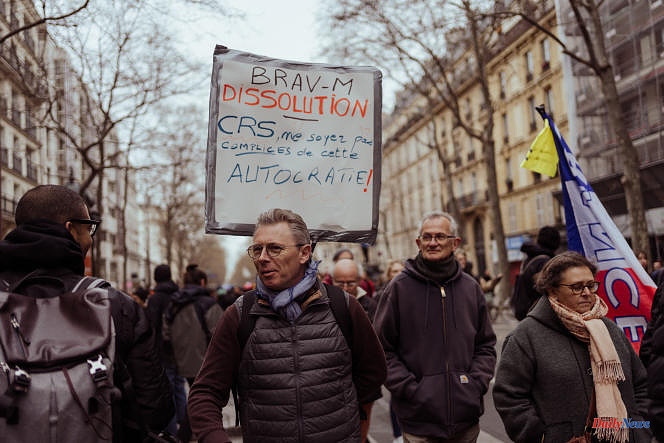It went viral within a week. The petition calling for the dissolution of the highly contested Brigade for the Repression of Violent Motorcycling Action (BRAV-M), posted on March 23 on the platform of the National Assembly, passed the 200,000 signature mark on Thursday March 30, against a backdrop of escalating violence in the movement protesting the pension reform, and following violent clashes between environmental activists and police in Sainte-Soline, Saturday March 25, two days after its deposit.
Since the creation of the platform dedicated to the filing of petitions by the National Assembly, at the end of 2020, this petition is the first to reach more than 100,000 signatures. If it resulted in a debate in session at the Assembly, it would also be a first, since so far, none of the 827 filed online has ever taken the necessary steps.
From how many signatures can such a petition be considered by MPs? Within what framework and under what other conditions? Here is everything you need to know about the petitioning procedure in the National Assembly and its possible outcomes.
• The deposit and signature procedure in brief
Any adult, of French nationality or legally residing in France can file or sign a petition on the platform of "citizen petitions of the National Assembly".
That "for the dissolution of the BRAV-M", was by a man named Yann Millérioux, union representative and leftist activist from Seine-Saint-Denis. It was put online on Thursday March 23, after the validation of its admissibility by the services of the Assembly. The initiative is supported in particular by elected leftists, first and foremost all the "rebellious" deputies, as well as several elected environmentalists.
As with any petition submitted on the platform, it is necessary to identify yourself via your FranceConnect account to become a signatory. An anonymous account is then generated in order to guarantee "both the anonymity of all signatories and the fact that each petition can only be supported once by an adult natural person".
"By default, the deadline for collecting signatures is set at the end of the current legislature, that is to say five years after the last legislative elections", specifies the site. The petition for the dissolution of the BRAV-M was therefore given a deadline of June 15, 2027 for its filing. Moreover, at the end of each legislature, "all petitions lapse" and are automatically filed.
• Once online, a possible review in committee
Any petition filed on the platform and exceeding the milestone of 100,000 signatures, as the petition to ban the BRAV-M reached on Monday, March 27, is granted "more visibility" by posting it online on the site of the National Assembly, in addition to its presence on the independent platform dedicated to their filing. A petition that reaches 100,000 signatures is also set a new deadline for collecting signatures, one year after the date of crossing this threshold.
In accordance with the procedure, any petition posted online is attached to one of the eight permanent committees of the Palais-Bourbon, depending on its theme. That aimed at banning the BRAV-M was attached to the law commission, chaired by the deputy Sacha Houlié (Renaissance). Its members must then designate a Deputy-Rapporteur, referent of his committee on the petitions which fall to him.
It is then up to him to decide on any follow-up to be given to the petition. "On the proposal of the rapporteur, the committee decides [then], depending on the case, either to close the petition or to examine it", underlines the rules of the Assembly. As part of the BRAV-M petition, Eric Poulliat, Renaissance MP for Gironde, was appointed to this position on Wednesday March 29. He must submit his decision, Wednesday, April 5 afternoon, to the 73 members of the commission who will vote.
In the event that the committee decides to debate the petition submitted to it, it may "associate in its debates the first signatories of the petition". At the end of the latter, it must then publish "a report reproducing the text of the petition as well as the report of its debates".
On the other hand, in the event that a petition is closed by the committee, "this one is closed for signature", as 67 petitions have already been since 2020 - mostly due to the end of the deadline for collecting the necessary signatures – without any recourse being possible on the part of its authors. A remedy exists, however, if any deputy "requests from the Conference of Presidents that a petition classified by the committee be the subject of a debate in public session, on the condition that this request be made within a period eight days following the decision".
In the case of the BRAV-M petition, "the rapporteur's decision or the result of the committee vote should not be read as 'for or against' the dissolution of BRAV-M. This is not a commission of inquiry. At this stage, we are called upon to rule on the admissibility of the petition, before the potential holding of a debate, “said Mr. Poulliat to Le Monde.
• The conditions for a debate in public session
This is the ultimate step aimed at by the signatories of any petition submitted on the platform: the examination of its content by the deputies in public session, during a debate without a vote. The decision rests whatever happens with the Conference of Presidents of the Assembly, which can organize the holding of such a debate if:
What happens if a petition reaches 500,000 signatures even before its examination in committee, i.e. before the deadline of Wednesday, April 5, with regard to the petition requesting the dissolution of the BRAV-M? The regulations do not provide for this scenario. The Conference of Presidents should wait for the committee to submit its report before the debate is entered in public session, it is specified in the entourage of the presidency of the Assembly.
If the committee considers this petition inadmissible, the Conference of Presidents could reserve the possibility of submitting it despite everything to the debate of the deputies in the hemicycle. Whatever happens, the final decision rests with the Conference of Presidents, whose arbitrations cannot be appealed.












